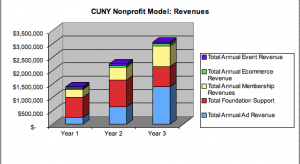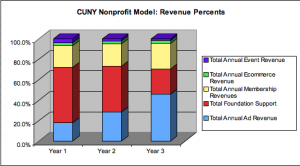Counting on Membership, Redrawing our Not-for-Profit Model
Posted on 23. Sep, 2009 by Matthew Sollars in Not-For-Profit
We’ve heard a fair bit of criticism in recent weeks that the revenue estimates (mostly in advertising) in some of our for-profit models were far too high. So, we are surprised to hear from Jim Barnett that the membership projections in our not-for-profit model are too low.
 By his lights, a not-for-profit like the one we envision (not unlike the real-life MinnPost), could reasonably generate more than $700,000 in membership revenues by year three, compared to the $547,000 we had estimated. Barnett, a journalist who is studying not-for-profit management at The George Washington University, was kind enough to plug his own assumptions into our model. His revision is available as an Excel download here.
By his lights, a not-for-profit like the one we envision (not unlike the real-life MinnPost), could reasonably generate more than $700,000 in membership revenues by year three, compared to the $547,000 we had estimated. Barnett, a journalist who is studying not-for-profit management at The George Washington University, was kind enough to plug his own assumptions into our model. His revision is available as an Excel download here.
Barnett started with a slightly higher number of member-donors in year one, taking the number of MinnPost members in its first 14 months and translating that to cover just 12 months. His calculations include some members not included in MinnPosts’s annual report (which was our source), arriving at a first year membership estimate of $298,000, roughly $25,000 more than our model.
 But the real differences start to show up in years two and three as the news organization matures and puts roots deep into the community. Barnett estimates that by year three the not-for-profit should aim for a five-fold increase in the total number of members, to 4,157 from 762.
But the real differences start to show up in years two and three as the news organization matures and puts roots deep into the community. Barnett estimates that by year three the not-for-profit should aim for a five-fold increase in the total number of members, to 4,157 from 762.
Barnett, who is studying not-for-profit management at George Washington University, says his assumptions draw on studies of membership efforts at mature not-for-profits. Typically, a robust membership drive will result in a pyramid where the majority of donors are at the lower contribution levels. Rather than extrapolating membership based on a conversion of estimated unique visitors (as in our model), Barnett has drawn a picture of what a healthy membership pyramid for a metropolitan news organization should look like in three years. Even with his more robust assumptions, however, Barnett’s organization still converts just one percent of estimated unique visitors. Indeed, the lowest rung accounts for much of the growth in Barnett’s model while membership at higher levels grows more slowly and actually decreases in the highest.
While there isn’t a defined statistical correlation between the top and bottom of the pyramid, Barnett says there is a relationship.
“It’s a social process, people see what leaders in the community and their peers are giving and say they want to be a part of that,” Barnett says. “People start small and work their way up. Not every body will move up the ladder, not everybody who moves up will go to the top, but the end game as a not-for-profit is to make this a part of people’s lives. When there’s a socialization to it, that’s when you start getting the reinforcing numbers at the lower end.”
More and more journalists, casting about for ways to preserve their livelihood, have been drawn to the not-for-profit model. The Voice of San Diego announced last week that it will provide advice and support to an offshoot in nearby Orange County and Spot.Us has launched a franchise in Los Angeles. But, as Barnett makes clear in a post on ProPublica’s effort to start finding alternatives to foundation grants, launching a not-for-profit cannot be a “tin-cup substitute” for journalists who balk at running a business.
“A lot of these organizations get the grant money but then struggle to make it on their own, he says. “That’s what this is about, how to go from being hatched to going out in the wild to survive.”
Want to add your own assumptions to our models? Go right ahead! And, please, shoot them back to us. (The New Business Models for News Project has been funded by the Knight Foundation.)
2 Responses to “Counting on Membership, Redrawing our Not-for-Profit Model”
Trackbacks/Pingbacks
-
-
September 23, 2009
[…] Counting on Membership, Redrawing our Not-for-Profit Model It’s a social process, people see what leaders in the community and their peers are giving and say they want to be a part of that,” Barnett says. “People start small and work their way up. Not every body will move up the ladder, not everybody who moves up will go to the top, but the end game as a not-for-profit is to make this a part of people’s lives. When there’s a socialization to it, that’s when you start getting the reinforcing numbers at the lower end.” (tags: business) […]



links for 2009-09-23 | Joanna Geary
24. Sep, 2009
[…] Counting on Membership, Redrawing our Not-for-Profit Model It’s a social process, people see what leaders in the community and their peers are giving and say they want to be a part of that,” Barnett says. “People start small and work their way up. Not every body will move up the ladder, not everybody who moves up will go to the top, but the end game as a not-for-profit is to make this a part of people’s lives. When there’s a socialization to it, that’s when you start getting the reinforcing numbers at the lower end.” (tags: business) […]
Sorry… forgot to say great post – can’t wait to read your next one!